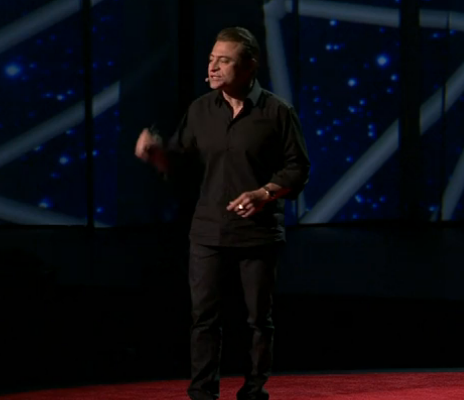So let's project this analogy going forward. We think about energy scarcity.
讓我們把這個比喻應用到其他方面,讓我們想一想能源短缺。
Ladies and gentlemen, we are on a planet that is bathed with 5,000 times more energy than we use in a year.
女士們先生們,我們生活的這個星球上接收著相當于我們年平均能源消耗5000多倍的能量。
16 terawatts of energy hits the Earth's surface every 88 minutes. It's not about being scarce, it's about accessibility.
每88分鐘有16太瓦的能源投向地球表面。問題并不是能源稀缺,而是可及性。
And there's good news here. For the first time, this year the cost of solar-generated electricity is 50 percent that of diesel-generated electricity in India -- 8.8 rupees versus 17 rupees.
現在有幾個好消息,今年是有史以來第一次在印度,太陽能發電的成本降低至化石燃料發電成本的一半--8.8盧布相比較17盧布。
The cost of solar dropped 50 percent last year. Last month, MIT put out a study showing that by the end of this decade,
去年太陽能發電的成本降低了一半,上個月,MIT發布了一個研究報告,顯示到2020年,
in the sunny parts of the United States, solar electricity will be six cents a kilowatt hour compared to 15 cents as a national average.
在美國陽光充足的地區,太陽能電力費用會降至6美分一千瓦/小時,相比較全國平均標準是15美分。

And if we have abundant energy, we also have abundant water. Now we talk about water wars.
如果我們有充足的能源,也就會有豐富的潔凈水。下面我們來聊下水的戰爭。
Do you remember when Carl Sagan turned the Voyager spacecraft back towards the Earth, in 1990 after it just passed Saturn?
還記得嗎?1990年,Carl Saga在航海者太空飛船經過土星的時候,調轉其方向面對地球。
He took a famous photo. What was it called? "A Pale Blue Dot." Because we live on a water planet. We live on a planet 70 percent covered by water.
拍下了一幅著名的照片,叫什么名字?“淡藍色的小點”。因為我們生活在一顆“水行星”上,地球表面70%被水覆蓋。
Yes, 97.5 percent is saltwater, two percent is ice, and we fight over a half a percent of the water on this planet, but here too there is hope.
是的,97.5%是海水,2%是冰山,我們則在爭奪世界上1.5%的水資源,但我們仍然有希望。
And there is technology coming online, not 10, 20 years from now, right now. There's nanotechnology coming on, nanomaterials.
有一項科技正準備投入應用,并不是未來的10年20年以后,就是現在。有一種納米科技。
And the conversation I had with Dean Kamen this morning, one of the great DIY innovators, I'd like to share with you -- he gave me permission to do so --
今天早上我和一個偉大的DIY發明家Dean Kamen聊天。我想要和大家分享-我得到了他的允許-
his technology called Slingshot that many of you may have heard of, it is the size of a small dorm room refrigerator.
他開發的技術叫做“彈弓”,在座的一些朋友可能聽說過,它是一個小房間一般大的冰箱,
It's able to generate a thousand liters of clean drinking water a day out of any source -- saltwater, polluted water, latrine -- at less than two cents a liter.
每天可以從任何水源中-海水,污染水,公共廁所-生產出一千公升的潔凈飲用水。每公升的成本低于2美分。
The chairman of Coca-Cola has just agreed to do a major test of hundreds of units of this in the developing world.
可口可樂的主席最近授意,在多個發展中國家對數百臺“彈弓”進行大規模測試。
And if that pans out, which I have every confidence it will, Coca-Cola will deploy this globally to 206 countries around the planet.
如果測試成功,我很有信心它會成功,可口可樂將會在全球206個國家對該設備進行部署。
This is the kind of innovation, empowered by this technology, that exists today.
這就是當下已經存在的由科技驅動的創新。











